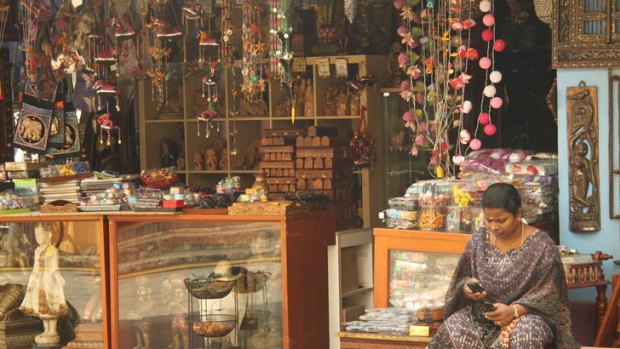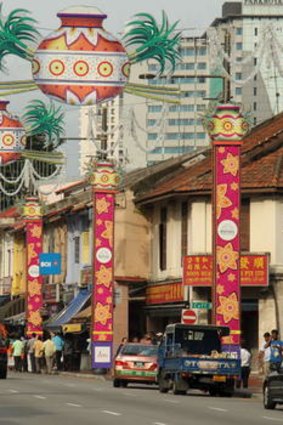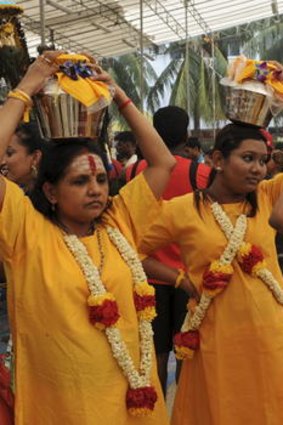
Little India.Credit: Richard Tulloch
The smells, colours and food stalls of Little India take Richard Tulloch by surprise as he happily loses himself in the throng.
IT WAS a Singaporean taxi driver who first alerted me to the charms of Little India.
"How is your hotel, sir? Are you receiving satisfaction?" he said.
I was guarded, knowing where such discussions with taxis drivers can sometimes lead.
"It's OK." It was fine; a comfortable, generic hotel near Singapore's main shopping drag, Orchard Road.
"Are you enjoying a good breakfast there, sir?"

Serangoon Road.Credit: Richard Tulloch
"It's not bad." Congealed scrambled eggs and dry bacon from the bain-marie, lukewarm filter coffee, canned fruit salad and mini cereal packets.
"Next time you are coming to Singapore, sir, I recommend you should stay in Little India. Very, very excellent price hotel. Breakfast round the corner, very, very cheap, sir." He went on to name his preferred establishments.
I took his advice on my next trip and, surprise, surprise, it turned out very, very well. The hotel had a very, very clean bed that just fitted into a very, very small room.

Thaipusam festival.Credit: AFP
The bathroom was not so much a bathroom as a shower cubicle with a toilet inside. Next time, I'll use the toilet before showering and thus have a dry seat. But why quibble? It was half the price of Hotel Generic.
When jetlag forced me into the pre-dawn streets, there on opposite corners of Kampong Kapor Road were the gaudy blue MBS Restaurant and its gaudy orange Thai Muslim seafood competitor, LK Maju Restaurant.
Feeling 5.30am was a bit early for Thai Muslim seafood, I chose breakfast at MBS - prata, a large pancake, fried with an egg inside, accompanied by dhal and a generous mug of teh tarik.
This teh tarik turned out to be Malay "pull tea", thick and sweet, prepared by pouring it deftly from jug to jug to mix in condensed milk. Total cost was $S2.30 (less than $2) and not a mini cereal packet in sight. There was a continuous show passing my roadside table: thin, dark young men rode rickety bicycles; a bent, wizened figure wheeled a handcart piled high with flattened cardboard boxes and was overtaken by an open truck marked "Summit Scaffolding and Engineering", ferrying its cargo of workers to one of Singapore's numerous building sites; a tall, turbaned gentleman pushed a shopping trolley.
This was Little India and I came to love it.
Packed into a few streets in a smart, modern city were the smells, the colours, the saris and dhotis, the hawkers, the temples and the street food of India.
The atmosphere, street names and some of the architecture may be olde worlde and the religious practices ancient but Little India has changed dramatically since its humble beginnings.
Local guide Charlotte led me around the markets, temples and back streets, filling me in on the history of the area.
Little India started as a penal colony, she explained.
Singapore had been a Chinese/Indian port since the 14th century but only really took off when the British made a trading base here.
In the mid-19th century, Indian prisoners from Jakarta were deployed to build Singapore's racecourse, which stood on the green field still bordered by Racecourse Road.
Tekka Market was getting ready for a day's trading. Fishmongers arranged heaps of trussed crabs, Chinese traders set out green vegetables and a butcher chopped meat on a huge Tembusu tree trunk.
Along busy Serangoon Road, the wooden facades of the old shop-houses were shabby above but thriving below with goldsmiths, phone card dealers, tailors, spice merchants and sellers of cheap shirts, suitcases, shoes and sandals doing brisk trade. There was some gentle, "Sir, come look, very good price for you, sir," but Singaporean hawking is nowhere near as persistent as in other places. We had missed the Thaipusam Festival of thanksgiving (late January or early February) during which devout Hindu masochists suspend heavy decorations from their pierced body parts and parade through the street to the Sri Veeramakaliamman Temple. It sounds spectacular, albeit with a strong cringe factor.
The temple opened in 1855, though what is now its most spectacular feature, the Gopuram, a mountain of carved figures surrounding the goddess Kali riding a lion, is comparatively new.
I'm sure I'm not alone in hesitating to stroll into places of worship. It seems culturally insensitive to be taking holiday snaps in a site that gives meaning to other people's lives but Charlotte assured me visitors were welcome. In the inner courtyard, devotees were presenting priests with garlands of flowers - white jasmine for purity, red roses for love and yellow marigolds for peace, along with prayers for success in family matters, financial deals and children's exams.
The priests, stripped to the waist, their faces daubed with white paint, brought the petitions forward to pass them on to the gods.
My favourite god, Ganesha, he of the elephant head, had bundles of grass included in his garlands.
He's the god of wisdom, patron of arts and science and the remover of obstacles. I liked the symbolism of his broken tusk, reminding us that even gods are not perfect.
Kali on the other hand is an exceptionally hard marker.
The gruesome depiction of her eating the intestines of a young woman was intended to impress upon the illiterate the penalty that awaits those who mistreat children.
Charlotte assured me the victim deserved her fate but nonetheless, Kali seemed to be taking an unseemly delight in her work.
The eastern end of nearby Dunlop Street and Dickson Road has become backpacker land.
Hostels such as Footprints and Inncrowd were surrounded by tapas restaurants, music lounges and trendy bars such as Barkode.
The Wanderlust, in Dickson Road, is a hip and quirky boutique hotel - the foyer furnished with barber's chairs and converted shopping trolleys.
Less way-out, modestly priced hotels are Santa Grand Little India and Dickson, part of the Hotel 81 chain. Over a few days I tried them all and was never disappointed.
Charlotte and I took a break and bought another teh tarik, though this time without a cup. I got the takeaway version, served in a dangling plastic bag and drunk through a straw. Tricky. The bag slipped from my fingers and burst, converting "pull tea" to "drop tea". Thanks, Charlotte, for being so nice about the damage to your shoes.
Lunchtime arrived. The signature dish of Ananda Bhavan vegetarian restaurant, Singapore's oldest, is dhosai, thin South Indian pancakes served with a variety of spicy accompaniments.
The mango lassis (fruit and yoghurt drinks) were brilliant. Cost was less than $10, leaving me money over to go shopping.
The Mustafa Centre is the place to buy practically anything at any time of day, at a cut rate.
It might possibly be cut quality, too (the suitcase I bought there didn't last long but you get what you pay for).
It was the ideal place for stocking up on clean shirts to supplement those I needed to change twice daily in Singapore's heat and humidity.
Little India Arcade sells bright strings of elephants, handbags and woodcarvings and it's an interesting place to watch traditional craftsmen at work. Towering above it is Sim Lim Square - floor after daunting floor of electronic goods stores.
In a booming city that has become almost completely Westernised, with prices to match, Little India is one district that still retains a distinctively Asian atmosphere.
The cultural cauldron was evident in the faces in the street, the jostling crowds stepping around street stalls and dodging trucks, the washing flapping on clothes lines, the Bollywood music thumping from DVD shops, the vendors wrapping betel leaves and the pervasive aroma of cinnamon and cloves.
It may be India Lite but it looked, felt and smelled very real.
The writer was a guest of Santa Grand Hotels.
Trip notes
Getting there
Singapore Airlines flies Sydney to Singapore daily, singaporeair.com.
Staying there
Grand Hotel Santa has double rooms from $S180 ($134), santagrandhotels.com.
Wanderlust Hotel has double rooms from $S198 plus tax, wanderlusthotel.com. Inncrowd hostel dorm bed costs $S20, the-inncrowd.com.
Eating there
Ananda Bhavan vegetarian restaurants, anandabhavan.com.
More information
Charlotte Chu runs private walking tours of Little India for individuals and small groups, charlottechutours@gmail.com. Group walking tours of Little India, every Wednesday, cost $S30 a person, journeys.com.sg.
Sign up for the Traveller Deals newsletter
Get exclusive travel deals delivered straight to your inbox. Sign up now.